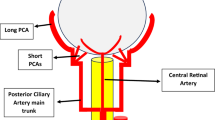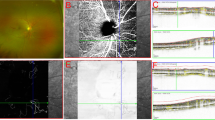Summary
To investigate the features of CT, ultrasonography and fundus fluorescein angiography (FFA) of morning glory syndrome, the data on CT, A/B-scan ultrasonography and fundus fluorescein angiography (FFA) were retrospectively analyzed in 8 cases of morning glory syndrome (MGS). Among those cases, 6 were examined with CT, 4 with FFA and 8 with A/B-scan ultrasonography. Results showed that the characteristics of CT, A/B-scan ultrasonography and FFA in MGS included: (1) The attachment spot of optic nerve became thin and vitreous body protruded to the posterior wall of eyeball with a spherical shape on CT image; (2) in the early period of FFA, hypofluorescence appeared on the optic, the abnormal arteriae and veins around the optic papilla were displayed clearly and in the late period, optic disc was stained with fluorescein; (3) on B-scan ultrasonogram, the vitreous cavity extended to the posterior pole and optic papilla, and projected to the basal part of muscle cones and thus the posterior part of vitreous cavity looked like an upside-down bottleneck. Sometimes the echogenic band of retinal detachment could also be seen. On A-scan ultrasonogram, both vitreous cavity and bottleneck showed no ultrasonic echoes and presented a base line without any evident wave crest. It is concluded that CT, A /B-scan ultrasonography and FFA could show the imageological features of MGS from different aspects, which helps clinicians to differentiate it from other diseases such as optic disc coloboma. CT and A /B-scan ultrasonography, in particular, are considered to be reliable imageological methods for the accurate diagnosis of MGS and are superior to the traditional techniques.
Similar content being viewed by others
References
Suzuki Y, Kawase E, Nishina S et al. Two patients with different features of congenital optic disc anomalies in the two eyes. Graefes Arch Clin Exp Ophthalmol, 2006, 244(2):259–261
Zhao X Q, Chen W M, Lin S C. Two cases of morning glory syndrome. Chin J Ocul Fundus Dis, 2005,21(4):263–264
Chaudhuri Z, Grover AK, Bageja S et al. Morning glory anomaly with bilateral choroidal colobomas in a patient with Goldenhar’s syndrome. J Pediatr Ophthalmol Strabismus, 2007,44(3):187–189
Görbe E, Vámos R, Rudas G et al. Neuronal migration disorders, agenesis of corpus callosum, preauricular skin tag and bilateral morning glory syndrome in a term newborn infant. Clin Dysmorphol, 2008,17(2):123–125
Miller N R. Walsh and Hoyt’s clinical neuro-ophthalmology. 4th ed, Baltimore: Williams Wilkins, 1982.3
Kim M R, Park S E, Oh S Y. Clinical feature analysis of congenital optic nerve abnormalities. Jpn J Ophthalmol, 2006,50(3):250–255
Ho C L, Wei L C. Rhegmatogenous retinal detachment in morning glory syndrome pathogenesis and treatment. Int Ophthalmol, 2001,24(1):21–24
Handmann M. Erbliche Vermutlich angeborene Ientralgefaesse. Klin Monatsbl Augeaheikd, 1929,83:145.
Kindler P. Morning glory syndrome: unusual congenital optic disk anomaly. Am J Ophthalmol, 1970,69(3):376–384
Chaudhuri Z, Grover A K, Bageja S et al. Morning glory anomaly with bilateral choroidal colobomas in a patient with Goldenhar’s syndrome. J Pediatr Ophthalmol Strabismus, 2007,44(3):187–189
Akamine T, Doi M, Takahashi H et al. Morning glory syndrome with peripheral exudative retinal detachment. Retina, 1997,17(1):73–74.
Taban M, Marcotty A, Traboulsi E I. Optic disc coloboma and localized chorioretinal defects in constitutional partial trisomy 8 mosaicism. Ophthalmic Genet, 2006,27(3):103–105
Torralbo A, Nebro S, Remartínez E et al. Morning glory optic disc anomaly associated with chronic renal disease. Nephrol Dial Transplant, 1995,10(9):1762–1764
Bartz-Schmidt K U, Heimann K. Pathogenesis of retinal detachment associated with morning glory disc. Int Ophthalmol, 1995,19(1):35–38
Taşkintuna I, Oz O, Teke M Y et al. Morning glory syndrome: association with moyamoya disease, midline cranial defects, central nervous system anomalies, and persistent hyaloid artery remnant. Retina, 2003,23(3):400–402
Chen C S, David D, Hanieh A. Morning glory syndrome and basal encephalocele. Childs Nerv Syst, 2004,20(2):87–90
Saglam M, Erdem U, Kocaoglu M et al. Optic disc coloboma (the morning glory syndrome) and optic nerve coloboma associated with transsphenoidal meningoencephalocele. Eur J Radiol Extra, 2003,45,71–76
Sobol W M, Bratton A R, Rivers M B et al. Morning glory disk syndrome associated with subretinal neovascular membrane formation. Am J Ophthalmol, 1990,110(1):93–94
Marphy B L, Griffin J F. Optic nerve coloboma (Morning glory syndrome): CT findings. Radiology, 1994,191:59–61
Okada K, Sakata H, Shirane M et al. Computerized tomography of two patients with morning glory syndrome. Hiroshima J Med Sci, 1994,43(3):111–113
Harasymowycz P, Chevrette L, Decarie J C et al. Morning glory syndrome: clinical, computerized tomographic, and ultrasonographic findings. J Pediatr Ophthalmol Strabismus, 2005,42(5):290–295
Wu J, Zhou L, Mo Y et al. B-scan ultrasonic imaging of morning glory syndrome. Eye Sci (Chinese), 1998,14(2):103–104
Author information
Authors and Affiliations
Corresponding author
Additional information
Jun HU, male, born in 1970, Doctor in Charge
This project was supported by a grant from the Natural Sciences Foundation of Hubei Province of China (No. 2007ABA108).
Rights and permissions
About this article
Cite this article
Hu, J. The clinical characteristics and imaging findings of morning glory syndrome. J. Huazhong Univ. Sci. Technol. [Med. Sci.] 28, 465–468 (2008). https://doi.org/10.1007/s11596-008-0420-2
Received:
Published:
Issue Date:
DOI: https://doi.org/10.1007/s11596-008-0420-2




